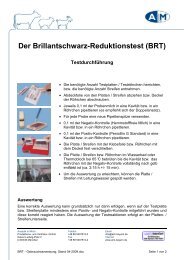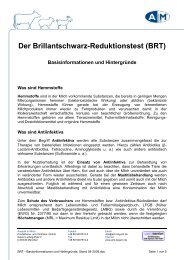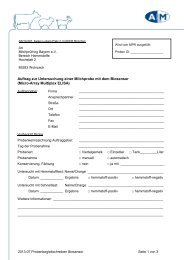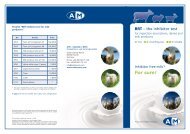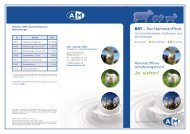BRT - Analytik in Milch Produktions- und Vertriebs GmbH
BRT - Analytik in Milch Produktions- und Vertriebs GmbH
BRT - Analytik in Milch Produktions- und Vertriebs GmbH
You also want an ePaper? Increase the reach of your titles
YUMPU automatically turns print PDFs into web optimized ePapers that Google loves.
The <strong>BRT</strong> systems of <strong>Analytik</strong> <strong>in</strong> <strong>Milch</strong> <strong>GmbH</strong>AiM offers the follow<strong>in</strong>g <strong>BRT</strong> systems:<strong>BRT</strong> Inhibitor TestThis test was developed especially for the detection of <strong>in</strong>hibitors <strong>in</strong> milk, and dist<strong>in</strong>guishesitself by its particularly high sensitivity to β-lactam antibiotic residues. The maximumresidue limits (MRLs) laid down by the EU are reliably encompassed by the <strong>BRT</strong> InhibitorTest (see follow<strong>in</strong>g table); other antibiotics and sulfonamides present will also bedetected.The <strong>BRT</strong> Inhibitor Test is particularly designed to fulfil the demands of milkquality regulation <strong>in</strong> Germany, but can also be used successfully <strong>in</strong> other countries <strong>in</strong>quality evaluation and payment for tanker milk. It is produced accord<strong>in</strong>g to CommissionDecision 91/180/EEC and § 64 LFGB (before § 35 LMBG) Method 01.01-5.<strong>BRT</strong> MRL Screen<strong>in</strong>g TestThe MRL Screen<strong>in</strong>g Test is a modified <strong>BRT</strong> which is dist<strong>in</strong>guished by an <strong>in</strong>creasedsensitivity towards certa<strong>in</strong> antibiotics and sulfonamides. Besides the statutory maximums(MRLs) for β-lactam antibiotics, the test also encompasses substances from thesulfonamide group, macrolide group and am<strong>in</strong>oglycoside group to MRL level. Othersubstance groups are also detected with greater sensitivity than <strong>in</strong> the <strong>BRT</strong> Inhibitor Test(see follow<strong>in</strong>g table). The MRL Screen<strong>in</strong>g Test is used as a screen<strong>in</strong>g method for thedetection of anti-<strong>in</strong>fectives <strong>in</strong> quality control <strong>in</strong> dairy <strong>in</strong>dustry as well as <strong>in</strong> monitor<strong>in</strong>g tests.It is produced accord<strong>in</strong>g to Commission Decision 91/180/EEC and § 64 LFGB (before §35 LMBG) Method 01.00-11.Further <strong>in</strong>formation<strong>BRT</strong> – Backgro<strong>und</strong> and Basic Information<strong>BRT</strong> – Product Information<strong>BRT</strong> – Instructions for Use of Plates<strong>BRT</strong> – Instructions for Use of Tubes<strong>BRT</strong> – The Correct Incubation<strong>BRT</strong> – Use of Preserved Samples<strong>BRT</strong> – The Visual Evaluation<strong>BRT</strong> – The Photometric Evaluation<strong>BRT</strong> – Use of Milk ProductsStandards, lyophilisated – Product InformationPenicill<strong>in</strong>ase Product InformationShould you have any further questions or require any special <strong>in</strong>formation, please do nothesitate to contact us directly.<strong>BRT</strong> - Backgro<strong>und</strong> and Basic Information, 04-2009.doc page 4 of 4



